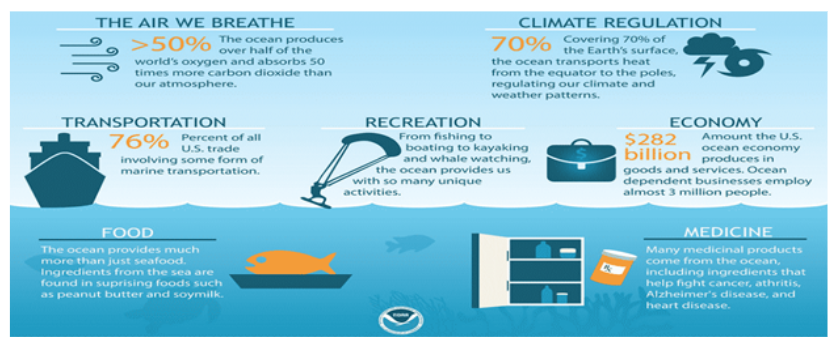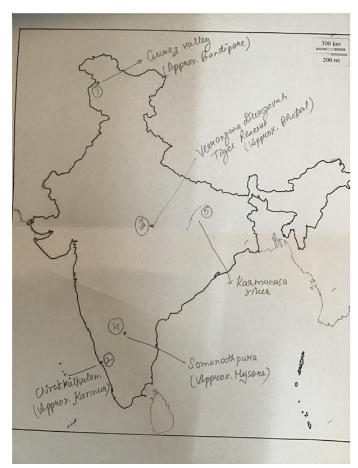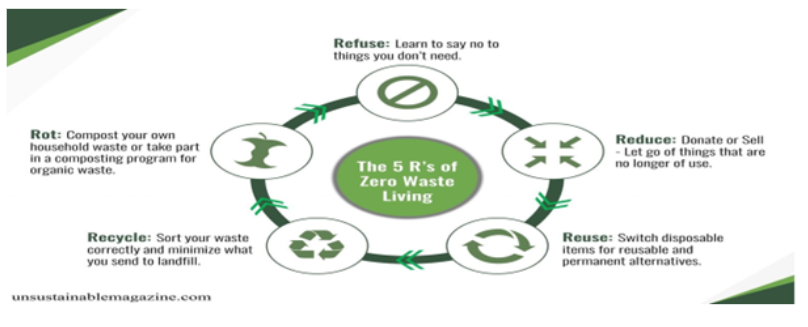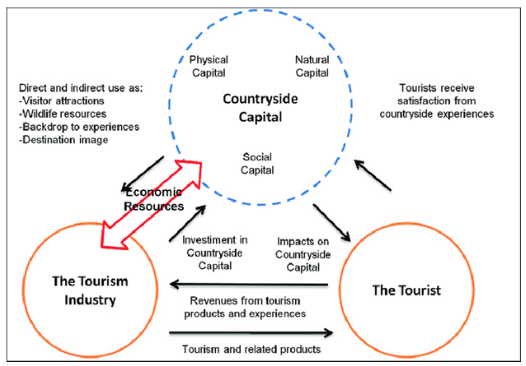24 Sep to 10 Oct, 2023
BLUE ECONOMY TO UNLOCK SEA OF OPPORTUNITIES
Why in news : India holds immense potential for the blue economy, which encompasses the sustainable use of ocean resources toward environmental sustainability
Background:
- The Blue Economy encapsulates the sustainable use of ocean resources for economic growth, improved livelihoods, and jobs, while preserving the health of marine and coastal ecosystems.
- Moreover, it acknowledges the oceans as both economic assets and global commons, emphasizing innovation, collaboration, and integrated management.
- The Blue Economy's significance lies in its potential to foster sustainable development, enhance coastal resilience, and address global challenges like food security and energy demands

DOMAINS OF BLUE ECONOMY
|
ENERGY |
|
|
MARINE TRANSPORT |
|
|
COMMUNICATION |
|
|
FOOD |
|
|
CARBON SEQUESTRATION |
|
|
RESOURCE MINING |
|
|
DEEP SEA RESEARCH |
|
|
TOURISM |
|
CHALLENGES TO BLUE ECONOMY
- Unsustainable Development Near Marine Areas: Rapid industrialization and urban sprawl along coastlines often result in habitat destruction and pollution. Example: In countries like Indonesia and the Philippines, coastal mangrove forests have been destroyed to make way for shrimp farming.
- Marine Pollution: Industrial run-offs, untreated sewage, and massive plastic waste influx are major pollutants affecting marine life. Example: The Great Pacific Garbage Patch, spanning 1.6 million square kilometers, is a floating testament to marine pollution.
- Impacts of Climate Change: Rising sea temperatures lead to coral bleaching, ocean acidification, and alter marine biodiversity. Example : The Great Barrier Reef, facing repeated bleaching events, jeopardizes Australia's marine biodiversity and tourism industry.
- Geopolitical Issues: Overlapping maritime boundaries can lead to disputes over resource exploration and extraction. Example: The South China Sea dispute involves multiple nations with claims over potentially oil-rich territories.
- Unfair Trade Practices: West African waters, rich in fish stocks, face overfishing largely due to illegal, unreported, and unregulated (IUU) fishing by foreign fleets, affecting local fishers.
- Deep-sea Mining Controversies: The race to tap into polymetallic nodules in the deep-sea bed for rare earth metals has sparked environmental concerns. Example: The Clarion-Clipperton Zone in the Pacific, rich in these nodules, is a focus of mining interests but also poses risks to unexplored deep-sea ecosystems.
|
CASE STUDY : CHINA AS BLUE ECONOMY China was an early and active adopter of the blue economy concept. One example of a small-scale blue economy initiative in China is the restoration of seagrass beds in the traditional fishing village of Chudao to support sea cucumber aquaculture. China is today a “fishery superpower”, which owns the world’s largest deep-water fishing (DWF) fleet, with boats that stay at sea for months or even years. China also uses a part of its fishing fleet as a “maritime militia”, which assists the navy and coast guard in their tasks. |
CONCERNS AND ISSUES
- Equity Concerns : The benefits of the blue economy might not be equitably distributed, leading to increased inequalities. Example: Coastal land grabs, where prime oceanfront properties are procured by developers, displacing local communities.
- Cultural Erosion: Indigenous knowledge and practices might be overshadowed by modern industrial methods. Example: Pacific Island communities facing loss of navigational knowledge due to reliance on modern tools.
- Sustainability Dilemma: The tension between sustainability and economic growth remains central to the blue economy discourse. Example : Tuna fisheries face this dilemma, where market demands often outweigh sustainable fishing practices.
ISSUES AND CHALLENGES FACED BY INDIA:
- Overfishing and Unsustainable Fishing Practices: The use of trawl nets, which catch juvenile fish and can damage the seafloor, has been widespread along the Indian coastline.As per Central Marine Fisheries Research Institute (CMFRI) reports, several commercially important fish species showed signs of over-exploitation in various coastal states.
- Marine Pollution: According to a study published in the journal 'Environmental Science & Technology', the Ganges river ranks among the top ten rivers worldwide that discharge the highest amount of plastic waste into the oceans
- Climate Change Impacts: The Sundarbans, the world's largest mangrove ecosystem, is facing threats from rising sea levels, which can lead to the loss of biodiversity and increased human-wildlife conflicts.
- Lack of Comprehensive Maritime Infrastructure: While major ports like Mumbai and Chennai have developed infrastructure, many smaller ports lack modern facilities, leading to inefficiencies. The World Bank's 'Ease of Doing Business' rankings have consistently pointed out areas where India can improve in terms of trade across borders, which is directly linked to maritime infrastructure.
- Legal and Regulatory Hurdles: The lack of clarity on deep-sea mining regulations has made it challenging for businesses to invest in this potential blue economy segment.
- Evidence: In a report by the United Nations Conference on Trade and Development (UNCTAD), the regulatory environment was cited as a key factor influencing the development of the blue economy in several nations, including India.
- Skill Gap and Training: India's aquaculture sector has potential, but the lack of trained professionals in sustainable aquaculture practices can limit its growth.
- Evidence: Reports from industry bodies like FICCI (Federation of Indian Chambers of Commerce & Industry) have highlighted the need for skill development in the maritime sector.
BLUE ECONOMY AND INDIA’S INITIATIVES
|
Sagarmala initiative |
Aims to modernize ports, improve connectivity and logistics, and promote coastal community development. |
|
Shipbuilding Financial Assistance Policy |
Policy introduced in 2016 to provide financial assistance to Indian shipyards for the construction of ships. |
|
Pradhan Mantri Matsya Sampada Yojana |
Aims to increase fish production, modernize fishing infrastructure, and create employment opportunities in the sector. |
|
Deep Ocean Mission |
To explore the deep sea and harness its resources for national benefit. |
|
Coastal Regulation Zone notification |
It aims to balance the economic development of coastal areas with the conservation of coastal ecosystems and livelihoods of coastal communities. |
INDIA’S G 20 PRESIDENCY AND BLUE ECONOMY
- Key priority: India’s G20 presidency has prioritized the blue economy as a key area under the Environment and Climate Sustainability Working Group.
- Promote sustainable and equitable development: The aim is to promote the adoption of high-level principles for sustainable and equitable economic development through the ocean and its resources while addressing climate change and other environmental challenges.
- A guide for future G20 presidencies: India’s commitment to ensure continued discussions on this crucial subject and pave the way for future G20 presidencies.
- Communication and collaboration: Build an effective communication with all stakeholders to share best practices, foster collaborations for advancements in science and technology, promote public-private partnerships, and create novel blue finance mechanisms.
INTERNATIONAL CONVENTIONS
- United Nations Convention on the Law of the Sea (UNCLOS)
- International Convention for the Prevention of Pollution from Ships (MARPOL)
- International Maritime Organization (IMO) Conventions
CONCLUSION:
The Blue Economy is poised for significant growth in the next few years. Transitioning away from an agricultural industry towards a bluer economy will be demanding. This means that governments must work together to make blue economies sustainable, share research and know-how.
Where to use ?
Paper I ( Geography Optional ) : Marine resources , Marine Pollution Paper II ( Geography Optional ) : Contemporary issues
SIXTH MASS EXTINCTIONS MORE SEVERE THAN ESTIMATED
Why in News : Human actions fuel surge of genus extinctions; extinctions due in 18,000 years happened in last 5 decades
Background :
- Earth's history has been punctuated by several mass extinction events. Here's a brief rundown of the "Big Five" mass extinctions prior to the hypothesized sixth:
|
EXTINCTIONS |
CAUSE AND IMPACT |
|
Ordovician-Silurian Extinction (about 444 million years ago)
|
Cause: A combination of cooling periods, glaciation, and possibly gamma-ray bursts. Impact: Estimates suggest 85% of marine species became extinct.
|
|
Late Devonian Extinction (about 375-360 million years ago)
|
Cause: Multiple factors, including asteroid impacts, climate change, and oxygen-poor oceans. Impact: 75-80% of species, predominantly marine, went extinct over an extended period.
|
|
Permian-Triassic Extinction (about 252 million years ago) Often called "The Great Dying."
|
Cause: A combination of volcanic activity (Siberian Traps), methane hydrate release, and possibly asteroid impacts. Impact: Around 95% of marine species and 70% of terrestrial vertebrate species went extinct.
|
|
Triassic-Jurassic Extinction (about 201 million years ago)
|
Cause: Major volcanic events from the Central Atlantic Magmatic Province, climate change, and potential asteroid impacts. Impact: Around 80% of species, especially marine organisms and large amphibians, went extinct.
|
|
Cretaceous-Paleogene Extinction (about 66 million years ago) The one that ended the reign of the dinosaurs.
|
Cause: A combination of volcanic activity in the Deccan Traps (India) and the asteroid impact in the Yucatán Peninsula (Chicxulub crater). Impact: 75% of all species went extinct, including non-avian dinosaurs.
|
The Sixth Mass Extinction:
- Unlike the previous five mass extinctions, which were attributed largely to natural global disasters, the ongoing sixth mass extinction is primarily driven by human activities. This event is unique due to:
- Anthropogenic Causes: Factors such as habitat destruction, pollution, overfishing, introduction of invasive species, climate change, and overexploitation are leading to dramatic loss rates of species.
- Rate of Extinction: Current extinction rates are estimated to be 100 to 1,000 times the natural background rate, with predictions of many more losses within centuries if action isn't taken.
- Impacts on Human Civilization: As humans are the primary drivers, this extinction event has significant repercussions for human societies due to the loss of ecosystem services, food sources, and economic assets.
KEY FINDINGS:
- Around 10,000,000 African elephants roamed Earth at the beginning of the 20th century. Now, only about 450,000 remain.
- Researchers from the United States and Mexico revealed the current extinction crisis is impacting land vertebrates at the generic level.
- Birds suffered the heaviest losses with 44 genus extinctions, followed by mammals (21 genus extinctions), amphibians (five extinctions) and reptiles (three extinctions).
- Decline in insect populations can be disastrous as they play crucial roles in pollination, decomposition, and as part of the food chain.
- Many fungi are also under threat, impacting ecosystem functions and medical and agricultural research.
- The regions became more conducive to outbreaks of infectious diseases that jump from animals to humans. An example is Lyme disease, a bacterial infection spread to humans by infected ticks.
WHAT NEEDS TO BE DONE :
- Habitat Restoration: This isn't just about preventing destruction but actively rehabilitating ecosystems, from reforestation projects to coral gardening.
- Biodiversity-Centric Policies: Governments can integrate biodiversity considerations into all sectors, from urban planning to agriculture.
- Global Cooperation: Biodiversity loss and climate change are global issues. Collaborative international agreements like the Paris Agreement are steps in the right direction.
- Community Engagement: Indigenous and local communities, often the guardians of biodiversity, need to be at the decision-making table, ensuring traditional knowledge is integrated into modern conservation strategies.
- Reduction in Consumption: Overconsumption is a root cause of overproduction, leading to more waste, pollution, and resource exploitation. Adopting sustainable consumption practices can make a difference
CONCLUSION :
The sixth mass extinction serves as a loud wake-up call. While the situation is dire, it's also an opportunity for humanity to reimagine its relationship with nature, adopting a more symbiotic existence rather than a dominative one.
Where to use?
Paper I ( Geography Optional ) : Principles of Ecology, Human Ecological Adaptations.
ONE CHILD BORN EVERY SECOND OF NEXT 7 YEARS TO BE STUNTED IF SDG PROGRESS NOT ACCELERATED
ONE CHILD BORN EVERY SECOND OF NEXT 7 YEARS TO BE STUNTED IF SDG PROGRESS NOT ACCELERATED
Why in news: Sub-Saharan Africa will be most affected, with 86 million cases of stunting for children born between 2023 & 2030
About :
Stunting, wasting, and malnutrition are pressing global health concerns that have persisted despite international efforts. These issues have multifaceted causes, ranging from economic to environmental, and their prevalence demonstrates the challenges in achieving Sustainable Development Goal 2 (Zero Hunger) and related goals.
REASONS AND CHALLENGES ASSOCIATED WITH NUTRITIONAL ISSUES
- Economic Inequality: Economic disparities often result in unequal access to nutritious food, healthcare, and knowledge about proper nutrition. Example : Many low-income countries, and even pockets within middle and high-income countries, exhibit higher rates of stunting and malnutrition due to economic constraints.
- Food Insecurity: Insufficient food production, poor distribution mechanisms, and lack of affordability lead to food insecurity. According to the FAO, over 800 million people worldwide are chronically undernourished, primarily due to food insecurity.
- Poor Sanitation and Hygiene: Chronic infections, especially in the early years of life, can hinder nutrient absorption and lead to stunting. Nations with poor sanitation infrastructure often have higher stunting rates, as seen in parts of sub-Saharan Africa and South Asia.
- Lack of Access to Clean Water: Contaminated drinking water can cause illnesses that exacerbate malnutrition. UNICEF data indicates a correlation between regions lacking clean water access and higher rates of malnutrition.
- Inadequate Healthcare: Limited access to maternal and child health services can result in malnourished mothers giving birth to underweight babies.Countries with weak health systems, like those in conflict zones, frequently report high malnutrition rates among children.
- Limited Education and Awareness: Lack of knowledge about proper feeding practices and the importance of a balanced diet can lead to malnutrition. UNESCO highlights that improving female literacy positively correlates with better child nutrition.
- Climate Change and Environmental Factors: Changing climate patterns affect agricultural productivity, leading to food shortages.Droughts, exacerbated by climate change in regions like the Horn of Africa, have caused periodic famines, increasing malnutrition rates.
- Conflict and Displacement: Wars and conflicts disrupt food production and distribution. Conflict zones, such as Yemen and Syria, have seen significant increases in malnutrition among children due to prolonged warfare.
- Inadequate Breastfeeding Practices: Exclusive breastfeeding for the first six months is crucial, and many infants are not breastfed optimally. WHO reports indicate that only 40% of infants under six months are exclusively breastfed globally.
FAILURES IN ACHIEVING SDGs
- Insufficient Investment: Achieving Zero Hunger requires significant investments in agriculture, health, and education, which many nations fail to prioritize adequately.
- Lack of Policy Integration: Nutrition, being multidimensional, needs integrated policies spanning health, agriculture, sanitation, and education. Such coordination is often lacking.
- Inadequate Monitoring and Accountability: Tracking progress on SDGs demands robust data. Many nations lack the tools or mechanisms for effective monitoring.
KEY FINDINGS:
- According to Save the Children , Lack of concerted effort to control the growing rates of malnutrition globally can cause nearly 194 million children born through 2030 to be stunted.
- Sub-Saharan Africa will be most affected, with an estimated 86 million cases of stunting for children born between 2023 and 2030.It will be closely followed by South Asia with 67 million cases.
- The Eastern Asia and Pacific region is set to witness nearly 22 million stunted children, while the Middle East and North Africa brace for 9.6 million cases, and Latin and Central America anticipate 6.7 million children facing stunted growth.
- Pakistan and the Democratic Republic of Congo (DRC) stand among the top four countries expected to face the highest levels of stunting in the next seven years.
CONCLUSION :
The challenge of addressing stunting, wasting, and malnutrition is immense and requires a comprehensive, multi-sectoral approach. While significant progress has been made in some areas, global efforts need intensification to fully meet the Sustainable Development Goals.
Where to use ?
Paper II ( General Studies ) : Social issues
Paper I ( Geography optional ) : Food Security and Nutrition
Paper II ( Geography Optional ) : Concept of sustainable development
Bioinoculant
Bioinoculant : Bioinoculants are formulations comprised of microbes used as a tool in green agriculture. In phyto-microbiomes, microbes are abundant and they form holobiont ( host and many other species living ) in association with plant and plants flourish with microorganisms association.
Floodplain
Floodplain: Floodplains are the lands, adjacent to both sides of a river, that are submerged under water when a river swells.The shape and size of a floodplain depend on the side slopes of the river.If they are steep, the floodplain area is less, but if they are flat, the floodplain can span across kilometre. According to the report titled Human alterations of the global floodplains , Asia lost the biggest area of floodplains among all continents.
Planetary boundaries
Planetary boundaries: Planetary boundaries, often referred to as the “Planetary Boundaries Framework,” is a concept in Earth system science and environmental studies that identifies a set of critical environmental limits beyond which human activities could disrupt the stability and functioning of the Earth’s systems. According to a new study, published in the journal Science Advances, the world has breached six out of nine planetary boundaries necessary to maintain Earth's stability and resilience.
Biogeochemical flows
Biogeochemical flows: Biogeochemical flows are the pathways by which elements like carbon, phosphorus, nitrogen, and sulphur, or compounds like water, flow between living organisms and the environment. Human activities can alter these cycles by producing or consuming in different quantities.
String technology
String technology: String Technology involves the use of porous fibres twisted into strings, which have been meticulously engineered. These strings possess a water-loving (hydrophilic) core and a water-repelling surface. When one end of the string is immersed in a saltwater solution, capillary action is initiated, mimicking the way trees transport water from their roots to their leaves. As the water evaporates from the string's surface, it leaves behind salt ions, including sodium and lithium. Over time, as the salts become increasingly concentrated, they form sodium chloride and lithium chloride crystals, which can be easily harvested. Thus, completing the process of Lithium production by String Technology. Recently, a new technology called "String" has emerged, with the potential to streamline the extraction of lithium, a crucial component in batteries used in smartphones and electric vehicles
Gurez valley
1. Gurez valley :
Why in news ? The high-altitude passes of the Gurez valley in north Kashmir are all set to connect with the Mushkoh valley, in Kargil’s Drass Sector, Ladakh, the site of the war in 1999.
About:
- Located in the Kashmir valley.
- The valley lies near the Line of Control, which separates it from the Astore and Neelum districts of Pakistan-administered Kashmir.
- It has diverse fauna and wildlife including the Himalayan brown bear and the snow leopard. It is also home to ibex, musk deer and marmots.
- Approx location : Bandipore
2. Chirakkalkulam
Why in news ? Recently Rural development Minister has inaugurated the pond innovation here.
About:
- It is a small residential area near Kannur town of Kannur District, Kerala state, South India. It is located between Thayatheru and Kannur City.
- Chirakkalkulam's significance arises from the birth of the historic Arakkal Kingdom.
- Approx location : Kannur
3. Veerangana Durgavati Tiger Reserve
Why in news ? Veerangana Durgavati Tiger Reserve’ becomes Madhya Pradesh’s 7th protected habitat for big cats.
About:
- It is an extensive area of 2,339 square kilometers and is located approximately 20 kilometers from Bhopal. It spans three districts—Narsinghpur, Sagar, and Damoh.
- It will encompass areas within the Nauradehi (Wild Life) & Veerangana Drugavati Sanctuary, recognized for their ecological significance.
- It is a crucial requirement for the Ken-Betwa River linking project, adding another layer of significance to its preservation
- Approx location : Bhopal
4. Somanathpura
Why in news ? Recently, the Union Ministry of Culture has nominated Chennakeshava Temple for consideration as a World Heritage site for the year 2022-2023.
About:
- It is a town and Grama Panchayat in Tirumakudalu Narasipura, Mysore district in the state of Karnataka in India.
- It is located 38 kilometres from Mysore city and famous for the Chennakesava Temple.
- Approx location : Mysore
5. Karamnasa river
Why in news ? It is considered as one of the cursed rivers of India.
About:
- The Karmanasa River is a tributary of the Ganges.
- It originates in Kaimur district of Bihar and flows through the Indian states of Uttar Pradesh and Bihar.
- Along the boundary between Uttar Pradesh and Bihar it has the districts of Sonbhadra, Chandauli, Varanasi and Ghazipur on its left (UP side); and the districts of Kaimur and Buxar on its right (Bihar side).

Plastic waste management in Dehradun
- Earth5R, an Environmental Organisation initiated a project called ‘Know Your Plastics’ in Dehradun.The project aims at raising awareness about plastic waste and also aspires to increase recycling rates of products.
- Time limit was dedicated to segregating waste into six different categories: MLP(multi-layer packaging), PET( Polyethylene terephthalate) plastics, LDPE(Low Density Polyethylene), HDPE(High Density Polyethylene), Tetra packs and Synthetic fibers. Any other kind of waste that was found was included in the ‘other’ category.
- Most of the waste was found near school boundaries and comparatively lesser around the residential areas. The waste was collected and recycled by organisation.

Where to use ?
Paper III ( General Studies ) : Environment Management
Paper II ( Geography Optional ) : Ecological issues , Environmental degradation , Environmental awareness.
FORTNIGHTLY KOSMOS MCQ PRACTICE
Q1. Consider the following statements
- Wildlife Week is celebrated in India every year to coincide with the birth anniversary of Sardar Patel.
- The theme of 69th Wildlife Week was "Partnerships for wildlife conservation"
- The World Wildlife Fund established Wildlife Week in 1952 to increase awareness about the long-term aims of wildlife protection throughout India.
Which of the above-mentioned statements is/are correct?
- 1 and 2
- Only 2
- 1 and 3
- 2 and 3
Q 2. Which of the following statements is true regarding invasive plants and their impact on ecosystems?
- Invasive plants enhance the native biodiversity of ecosystems.
- Invasive plants have no significant effect on the health of ecosystems.
- Invasive plants can outcompete native species and disrupt ecosystem balance.
- Invasive plants are always beneficial for ecosystem stability.
Q 3. Consider the following statements regarding Climate Finance.
- The primary purpose of climate finance is to facilitate international trade in carbon credits.
- The Standing Committee on Finance is a body established under the World Bank to promote the coherence and coordination of climate finance efforts at the international level.
Which of the above-mentioned statements is/are incorrect?
- Only 1
- Only 2
- 1 and 2
- Neither
Q 4. Consider the following statements.
- The Coalition for Disaster Resilient Infrastructure (CDRI) is an international initiative aimed at greenhouse gas emissions from the industrial sector.
- The United Nations Development Programme (UNDP) partners with the Coalition for Disaster Resilient Infrastructure (CDRI) to support its objectives.
Which of the statements is/are correct?
- Only 1
- Only 2
- 1 and 2
- Neither
Q 5. Lhonak Lake, a picturesque high-altitude lake surrounded by snow-capped mountains, is located in the Indian state of:
- A) Himachal Pradesh
- B) Jammu and Kashmir
- C) Sikkim
- D) Arunachal Pradesh
Q6. Consider the following statements.
- Kondakarla Ava is a Lake and Tiger Sanctuary in Visakhapatnam of Andhra Pradesh.
- It is located in the foothills of Eastern Ghats
- The region consists of wet evergreen forests.
Which of the above statements are correct?
- 1 and 2
- Only 2
- 1 and 3
- 2 and 3
Q7. Consider the following statements.
- The Teesta River flows through the Indian states of Arunachal and West Bengal.
- The Teesta River rises in Bhutan, then flows through the Indian states before entering Bangladesh.
Which of the above statements are correct?
- Only 1
- Only 2
- 1 and 2
- Neither
Q 8. Consider the following pairs
- The sanctuary is an integral part of the Nilgiri Biosphere Reserve.
- Species like Asian elephant, deer and tiger are found there.
- The Christened Red-rumped Hawklet has been recently discovered here.
Which of the above statements are incorrect?
- 1 and 2
- Only 2
- 1 and 3
- 1, 2 and 3
Q 9. Consider the following pairs:
Mountains Countries
- Mont Blanc France
- Aconcagua South Africa
- Mount Elbert USA
Which of the above mentioned pairs are correct ?
- 1 and 2
- Only 2
- 1 and 3
- 1, 2 and 3
Q 10. Consider the following statements regarding the 15-minute city.
- It is a human-centered approach.
- It is designed to ensure day-to-day services like banks, pharmacies and supermarkets are all within a 15-minute walk or cycle of residents’ homes.
- The concept of a 15-minute city offers a solution to the issue of urban divide.
Which of the above statements are correct?
- 1 and 2
- Only 2
- 1 and 3
- 1, 2 and 3
Q 11. Circular migration is often associated with both benefits and challenges. Which of the following benefits are typically associated with circular migration, as mentioned in the article?
- Increased earnings for migrants.
- Improved skills and knowledge gained in the destination country.
- Decreased remittances sent back to the country of origin.
- Greater social status and respect for migrants upon their return.
- Reduced brain drain in the country of origin.
Select the correct options:
- A) 1, 2, and 4
- B) 2, 3, and 5
- C) 1, 2, and 5
- D) 3, 4, and 5
Q 12. Select the correct statements regarding the concept of "Climate Polycrisis".
- Climate Polycrisis refers to the interconnected and compounding crises related to climate change, affecting multiple sectors and domains.
- The primary cause of Climate Polycrisis is the depletion of the ozone layer due to human activities.
- Greenhouse gas emissions, including CO2, methane, and nitrous oxide, are major contributors to Climate Polycrisis.
- Climate Polycrisis mainly affects the environment and has minimal social and economic impacts.
- Lack of political will and collective action can hinder efforts to address the climate crisis and its associated challenges.
Select the correct options:
- A) 1, 3, and 5
- B) 2, 4, and 5
- C) 1, 2, and 3
- D) 3 and 5
Q 13. Consider the following statements regarding Kole Wetlands.
- It is in the state of Tamil Nadu, and Ramsar site of international importance for its rich biodiversity.
- It is situated in the Central Asian Flyway of migratory birds
Which of the above statements are correct?
- Only 1
- Only 2
- 1 and 2
- Neither
Q 14. Recently seen in the news, Kaobal Gali-Mushkoh Valley, known for its strategic importance, is located in which region of Jammu and Kashmir?
- A) Ladakh
- B) Jammu
- C) Kashmir Valley
- D) Kargil
Q 15. Kongthong Village, awarded the 'Best Tourism Village (Bronze)' at the National Tourism Awards 2023, is situated in which Indian state?
- A) Assam
- B) Meghalaya
- C) Manipur
- D) Arunachal Pradesh
Share the article
Edukemy’s Current Affairs Quiz is published with multiple choice questions for UPSC exams
MCQ
Get Latest Updates on Offers, Event dates, and free Mentorship sessions.

Get in touch with our Expert Academic Counsellors 👋
FAQs
Geography Current Affairs focuses on the contemporary issues, events, and developments in the field of geography. It covers recent geographical phenomena, environmental changes, geopolitical shifts, and related news. This differs from regular geography studies which may focus more on foundational concepts, historical contexts, and theoretical frameworks.
Updates are provided regularly to ensure that subscribers stay informed about the latest developments in geography. Typically, updates are provided on a fortnightly basis, depending on the frequency of significant events and changes in the field.
Absolutely. Geography Current Affairs serves as a valuable resource not only for Geography optional but also for GS papers, especially GS Paper 1 (covering Indian Heritage and Culture, History, and Geography of the World and Society) and GS Paper 3 (covering Technology, Economic Development, Biodiversity, Environment, Security, and Disaster Management). It aids in building a holistic understanding of various topics and strengthens answer-writing skills by incorporating contemporary examples and perspectives.
Geography Current Affairs holds immense importance for UPSC preparation, particularly for aspirants opting for Geography optional. It helps candidates stay updated with the latest developments, geographical phenomena, environmental issues, and geopolitical shifts worldwide, aligning them with the dynamic nature of the subject as tested in the UPSC examinations.



